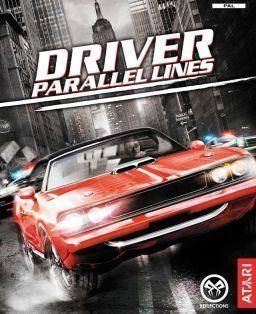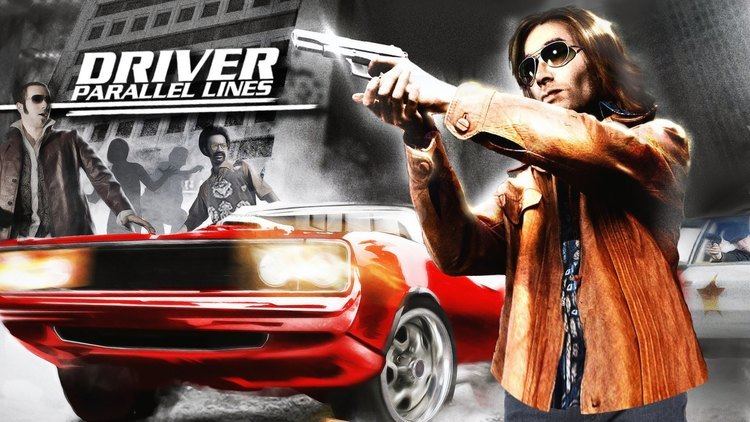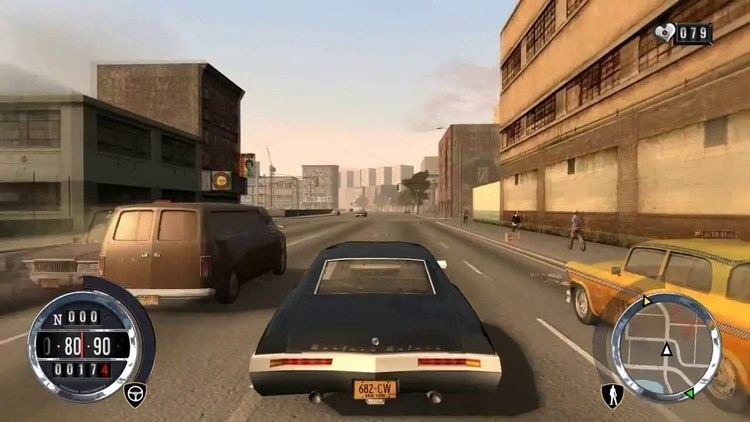7.6 /10 1 Votes7.6
61% Metacritic Initial release date 14 March 2006 Designer Atari | 9/10 Steam Mode(s) Single-player Series Driver | |||||||||||||||||||||||||||||||||
 | ||||||||||||||||||||||||||||||||||
Distributor(s) Electronic Arts (South America) Release date(s) PlayStation 2NA: March 14, 2006EU: March 17, 2006AU: March 30, 2006JP: October 12, 2006XboxNA: March 14, 2006EU: March 24, 2006Microsoft Windows & WiiNA: June 26, 2007AU: June 28, 2007EU: June 29, 2007 Similar Driver games, Ubisoft games, Racing video games | ||||||||||||||||||||||||||||||||||
Driver: Parallel Lines is the fourth installment in the Driver video game series. It is a departure from previous titles in the series that focused on multiple cities, as the game takes place in New York City, within the periods of 1978 and 2006. It is also the only title not to involve undercover cop, John Tanner, but instead focuses on a get-away driver named T.K., who seeks revenge on a gang he worked with during his youth, after they framed him for the murder of a drug lord they held for ransom. Due to the underwhelming performance of Driv3r, particularly the often-derided on-foot sections, Parallel Lines returns to the formula used in earlier games in the series, focusing on driving, although shooting remains in the game, while the game is more open-ended than previous titles. It was released in March 2006 on the PlayStation 2 and Xbox by Atari, and on the Wii and Microsoft Windows in June 2007 by Ubisoft.
Contents
- Driver parallel lines pc gameplay 1080p
- Gameplay
- Setting
- 1978
- Prison time
- 2006
- Reception
- Soundtrack
- Limited Edition
- References

Driver parallel lines pc gameplay 1080p
Gameplay

Driver: Parallel Lines takes place in an entirely open world environment, in which mini-games are now accessed from the in-game world instead of from a menu, while the game also features some new elements that are common with Grand Theft Auto - visible blood when someone is shot, an "Auto-aim" feature (with manual aim also available), a money system, fully modifiable vehicles (with a test track to test out upgraded vehicles), and environment destruction (i.e., lamp posts can now be run over and fire hydrants can break, spewing water into the air). A new felony system is incorporated in Parallel Lines, which can differentiate between personal felony and felony "attached" to vehicles the player has used. If the player attracts police attention on foot or in a certain vehicle, the player can suspend their wanted level by losing the police and entering a "clean" car, though it can be reactivated if they spend too much time in the sight of a police officer, who will eventually recognize the player as "wanted." The same principle applies to out-of-car activities such as weapon use, in which players can holster their weapon in order to lose police attention until spotted committing illegal acts again. For the Wii version, the felony bar is replaced with a "stars" system, similar to that of Grand Theft Auto, which light up when the player attracts police attention. Like Grand Theft Auto, the game features fictional, yet distinct styles of vehicles based upon real automobiles that were in use within New York between the two periods.

The game was originally intended to include online multiplayer, but this was scrapped when it became apparent to the developers that they could not deliver a strong multiplayer mode and wanted to focus entirely on the single-player portion of the game. The control layout differs slightly from Driv3r in that swimming and jumping abilities were removed from the game, along with a separate control to do "burnouts". While this was practical on the pressure-sensitive buttons of the PS2 controller, it meant that if the game was played using a PC keyboard to drive vehicles, most of them would constantly do a burnout when accelerating at low speeds and thus reduce control. The instant replay film director mode of previous Driver games was also removed, with the only available cinematic mode being the fixed-perspective slow-motion "Thrill Camera."

The game's appearance changes significantly between 1978 and 2006. Not only does T.K.'s appearance change from his 70's look to a more modern appearance in 2006, so too do the weapons, pedestrians and vehicles. Vehicles stored in the garage from 1978 can be used in the 2006 era and vice versa, while modifications are more expensive in the modern era than in 1978. New York's scenery changes quite significantly in places, with Times Square's lights and commercial posts changing to reflect the era they are in. While the 1978 World Trade Center appears, in 2006 it's a cleared and closed site. In addition, the New York of 1978 has a rather sepia tone to it, whereas in 2006 the sky has been blue-tinted. The game's HUD, which is updated from that of Driv3r featuring a speedometer, a nitrous oxide meter, and an odometer displaying how many miles the player has driven in-game also changes in appearance, from a chrome style to an LED look. While the players can change between eras manually, it can only be done after completing the 32 missions of the story mode and unlocking the "Era Change" option. While the game completely lacks any kind of weather, it does retain a day-to-night cycle that provides notable atmospheric changes.
Setting
The interpretation of New York City in Parallel Lines is not GPS street-accurate like True Crime: New York City's Manhattan. Instead, it's a smaller but more stylized version of the city that includes all the boroughs except Staten Island, as well as Coney Island and parts of the New Jersey shore. For example, Downtown Brooklyn is present but is not accurate to its real-life counterpart. The total amount of roadways used for the game's versions of Manhattan, Brooklyn, New Jersey, Queens, and The Bronx comes to around 222.5 miles (358.1 km), making the game world larger than the combined total of all three cities (Miami, Nice, and Istanbul) found in Driv3r. The game's New York City is also more "lifelike" compared to previous games in the series - players can watch vendors sell donuts, hear NPC pedestrians talk rather than simply grunting and screaming, and take part in numerous side jobs such as cab driving and car towing. Several things are notably different in the game compared to that of real-life New York. One example of this is that the New York Police Department is simply renamed and referred to as "City Police" within the game.
While many of New York City's many landmarks, such as the Statue of Liberty, the Empire State Building, the Chrysler Building, Times Square, Central Park, the Colgate Clock in Jersey City and the Flatiron Building appear in both eras, the World Trade Center is only present in 1978. Players can access the Austin J. Tobin Plaza of the complex during that period, but cannot access it in 2006 as it is closed off by a blue colored wall. Furthermore, despite not being built until the 1980s, the World Financial Center is present in both eras opposite the World Trade Center. All of New York City's major bridges feature within the game, except the Verrazano-Narrows Bridge, the Whitestone Bridge, the Hell Gate Bridge, and the Throgs Neck Bridge, with the player capable of traversing them freely from the start unlike some Grand Theft Auto games. An elevated portion of the New York City Subway that runs from Manhattan to Coney Island is also part of the game world, with trains running on the above ground railway system; the subway system itself, is not accessible to the player as a means of transportation.
1978
T.K is a 18-year old kid who just arrived from the countryside to New York City, "looking to make good". Using his driving skills, he becomes known in the underworld as a wheelman and a getaway driver for robbers assaulting "nickel and dime" stores. He lives with his childhood friend Ray, who himself arrived in 1975 and after a short career as a wheelman, set up Ray's Autos tuning garage. T.K spends his time relaxing in Ray's room, racing and doing various odd jobs around town, stating that "after a couple of weeks, it felt like home."
Ray, wishing to move on up the criminal ladder, introduces T.K to Slink, owner of a popular club in Harlem, and he proves himself to him by doing some work for him and handling his skills with a gun. He is also introduced to a gangster known as The Mexican, whom he helps with his driving skills by delivering packages across the city and proving himself against the last driver, whom The Mexican has locked in his trunk as a punishment. Later on, he is also introduced to a local criminal called Bishop, who requests from T.K to infiltrate Riker's Island and smuggle out Candy, a local gangster jailed there. Meanwhile, T.K also helps Ray with his gambling debt by doing other odd jobs across the city to pay him off.
After meeting up with Slink, Bishop, The Mexican and Candy, he is introduced to Corrigan, a corrupt police officer who doubles as a drug dealer. Since cocaine has a large foothold on the New York drug market and will be a rising star in the 1980s, Corrigan's organization wishes to gain leverage over cocaine distribution, but their main issue is Rafael Martinez, a Colombian drug lord who holds a monopoly on the drug trade, so they plan to have him kidnapped and held for ransom, which will be used to start a prominent drug trade. After setting up an elaborate ambush, in which Candy proves crucial with his planning skills, they successfully kidnap him. After the Colombian Cartel relents and provides ransom, T.K is collected and escapes the Cartel's men across rooftops, with The Mexican providing cover for him. After the ransom is delivered to Corrigan, he suddenly shoots Martinez dead, while the rest of the gang leaves. Corrigan reveals that T.K is set to be the fall guy, he sells T.K out and shoots him. T.K survives, but is arrested, trialed and sentenced to 28 years in the notorious Sing-Sing prison.
Prison time
Finding himself locked up in Sing-Sing, T.K slowly plans his vengeance on the rest of the gang, and with help of Ray, hears a lot about them: Slink became a porn director, based in his Harlem club, running a major film and music studio, which was a front for large distribution of heroin and cocaine, provided by Bishop, who replaced Martinez's role as the New York drug kingpin, delivering shipments from Colombia. Candy ran "an empire of trash", distributing Slink's porn across the country and running a prostitution ring, and Corrigan, using powerful connections from the trio, rose to the role of New York's Chief of Police, mostly due to his involvement in T.K's arrest. However, The Mexican, disillusioned with the wealth from his share of the money, went bankrupt and became a poor, alcoholic bum working in an arcade in Queens.
2006
T.K is released in 2006 after serving his full 28-year sentence and is greeted by Ray. Immediately, he sets up to hunt The Mexican, since he is the easiest target, and Ray provides him with his location. T.K arrives at The Mexican's arcade store and confronts him, who responds by brandishing a shotgun and running away. T.K chases him to Coney Island and kills him after a long firefight with his friends.
Afterwards, Ray introduces T.K to Maria, Candy's business partner, in a shooting range, where Ray vouches for T.K's abilities and Maria offers him work, stating that he will meet Candy when she feels like it, and provides various jobs for him, which T.K accomplishes in order to get closer to Candy. Meanwhile, Ray researches on Slink and Bishop's business and provides T.K with vehicles and ammo in order to sabotage their ventures. However, during both Maria and Ray's jobs, T.K is mysteriously pursued by unknown men in black sedans attempting to kill him and sabotage his work. However, he manages to successfully destroy Slink's stores and sabotages a major drug deal between drug providers and Bishop's men by luring police in their deals across the city. He then sets out for Slink and Bishop, killing Slink in a car chase in Harlem after confronting him in his club, and Bishop himself challenges T.K to a duel in which he unfairly brings a tank. Still, T.K also eliminates Bishop. After joining forces with Maria, he meets with Candy in his house, where Candy escapes while his guards drug him. In a drug induced state, he chases Candy and kills him.
Afterwards, T.K goes to Ray's Autos to meet him, only to find Corrigan here. Corrigan reveals that Ray helped him on his behalf in exchange for Corrigan paying off his huge gambling debt, since his addiction only worsened since 1978. He also reveals that he first tried to eliminate T.K, but then let him go in exchange for eliminating the four, revealing that he is currently running for Mayor and to tie up loose ends, he is trying to erase all his connections to the 1978 kidnapping of Martinez. After explaining himself, he murders Ray, starting a firefight between him and T.K. Corrigan escapes, but T.K finds Maria hidden in the house. Maria explains that she is Martinez's daughter, revealing that she worked with Candy to track down her father's killer, now out for vengeance to capture Corrigan, but decides to spare T.K as he was the fall guy.
Maria and T.K do her best to undermine Corrigan, first by planting his limo with Slink's body in his mansion, and then planting a police car with Candy's body in a garage and bombing his office in the City Police headquarters. However, Corrigan enters witness protection and is planted in a safe house, which T.K infiltrates to capture him. After a huge chase across the city, while he is fleeing in a chopper, T.K shoots Corrigan down, crushing his helicopter. Corrigan climbs down, wounded, and T.K steps in front, planning to kill him when Maria arrives. Corrigan goads for T.K to kill him, stating that Maria will kill him too and that T.K wants him dead. However, T.K, much to Corrigan's chagrin, gives him to Maria's men, and Maria leaves with them. T.K, with his vengeance quest complete, walks away from the crash.
Reception
The game received "mixed or average reviews" on all platforms according to video game review aggregator Metacritic. Praise went towards the story, fixes and improvements over the previous title, but criticism went to the cleavage of some elements in the new formula and the unbalanced difficulty.
IGN gave the PS2 and Xbox versions 7.2 out of 10, praising the return of the series to its roots, and mentioned that "It's still not perfect, but it's not broken either." GameSpot gave the same versions 6.5 out of 10 and called it a competent GTA clone, but far from being recommendable. Eurogamer gave the PS2 version 6 out of 10, while stating that "There's not too much shame in trying to do what GTA does, of course (and at least it's not about bloody gang warfare for once), but while this is definitely a solid improvement on its dreadful predecessor, it needed to achieve a basic level of competence and build upon it, and it only does that to a very limited extent." 1UP.com gave it a C+ and stated, "Sure, it's derivative as hell, but there's nothing getting in the way of actually enjoying the game now."
Soundtrack
Driver: Parallel Lines features a mixed licensed and original songs soundtrack consisting of over 70 songs, ranging from 1970s-era rock and funk to modern alternative rock and rap songs. The songs play while the player is in a vehicle, as if they were on the radio. Notable groups featured on the soundtrack include Funkadelic, Can, Suicide, The Stranglers, War, Iggy Pop, Blondie, David Bowie, Parliament, The Temptations and Average White Band in the 1978 part of the game, and Public Enemy, The Roots, TV on the Radio, The Secret Machines, Kaiser Chiefs, Yeah Yeah Yeahs and LCD Soundsystem in 2006. The 1978 portion of the game also features some modern funk tracks recorded by session musicians especially for the game soundtrack. All music licensing and in-game composition was done by Nimrod Productions.
Also, the Xbox and PlayStation 2 versions have the same soundtrack as the other versions but have a few extra songs. This is most likely due to the PC and Wii versions being released by Ubisoft.
Limited Edition
A limited edition version of the game was released along with the regular version. The special edition, costing slightly more, includes an extra DVD containing information about the production of Parallel Lines as well as in-game videos and character profiles. Also included with the limited edition is the official soundtrack, including twelve tracks from the game. The PAL version is dubbed "Collectors Edition", and does not contain the DVD, featuring instead the soundtrack CD and a metal case.
